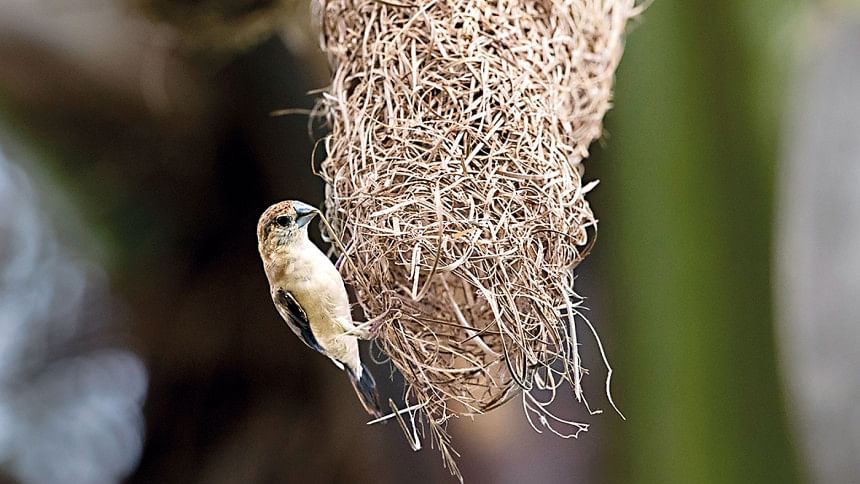The Weaver and the Munia

I love watching Baya Weaver (Babui) birds in their nests. They are ferociously energetic and constantly bringing nesting materials, building and upgrading their nests or chasing each other. Recently I had the opportunity to watch them in action after many months and got a surprise.
This was next to a fishpond in Hail Haor, Moulvi Bazar where several coconut trees supported the weaver's nests which hung from their fronds. Years ago, I had photographed Baya Weaver nests hanging from shupari trees, but coconut trees being shorter placed the birds closer to my camera. They have brown striped bodies similar in size and shape to the House Sparrow, but males have distinctive yellow crowns on their head. The weavers went about their construction business while chasing away suitors for their mate. Some tended to newly fledged chicks. They paid me scant attention as I watched with delight.
Then I noticed something unusual. On the side of a palm, several fronds had broken off and dangled from the trunk. A series of older Baya nests hung from these fronds. They looked untended and worn out. However, they were connected to each other making an awkward vertical string of nests which I have never seen before.
As I watched a bird flew to the bottom of one of these nests. It was an Indian Silverbill Munia! About the same size as a Baya Weaver, this munia looks brown from the top and white from below. Its broad and flat bill, distinctively silver, is used for extracting seeds from grass. (This is an important difference from the weaver whose sharper beak enables it to catch insects.) On its beak the munia had brought a long stalk of green grass. It perched from the vertical wall of the nest for a few seconds, scanning the surroundings. Still holding the grass it entered the nest through the opening in the bottom. After a few more seconds it flew out swiftly without the grass.
A few minutes later the munia returned. Again it perched on the nest wall. This time it had dried grass which it threaded into the nest with its beak. Then it was off again. The next trip it brought green grass, and this time I noticed the seeds hanging from the stalk. Like before, it went into the nest with the grass and flew out swiftly.
I realized that the munias were nesting in old, discarded Baya Weaver nests. Perhaps a storm had broken off the fronds and the weavers had lost interest in the nests they had built on them. The green grass the munias brought had seeds attached to them to feed the hatchlings inside the nest. But they also had to maintain the old nests, which they did with the dried stalks.
What struck me most was the difference in energy between the weavers and the munias. The weavers worked frantically without a break. The munias were slower paced and took many breaks: playing with each other, perching to rest and taking their time. While walking away, I saw a munia relaxing on a wire hanging over the field where it plucked its grass. It flew away to the grass field when it saw me. I know that birds don't have human emotions but I could swear this one was embarrassed at being caught idle!
.
facebook.com/ikabirphotographs or follow "ihtishamkabir" on Instagram.

 For all latest news, follow The Daily Star's Google News channel.
For all latest news, follow The Daily Star's Google News channel. 



Comments